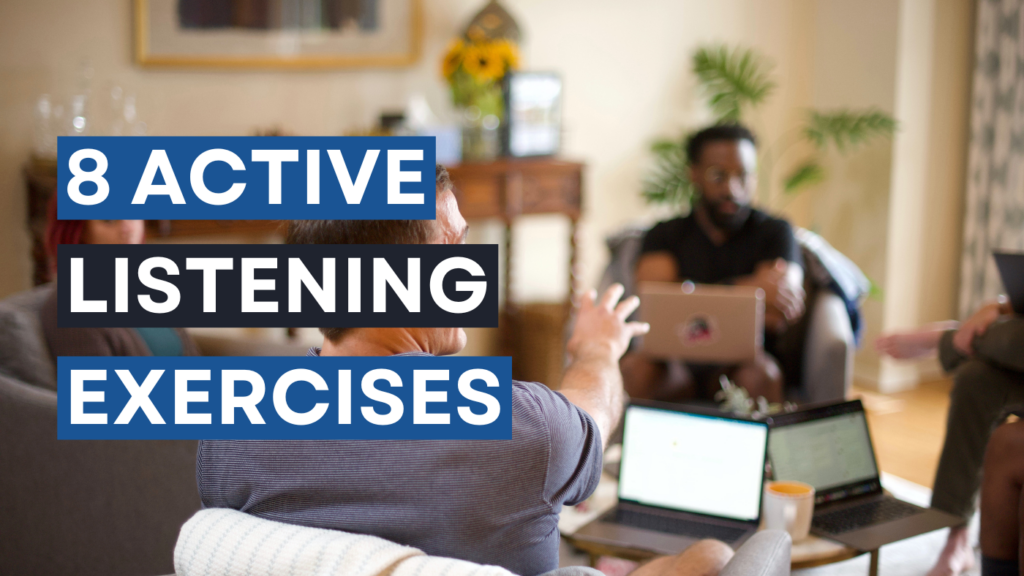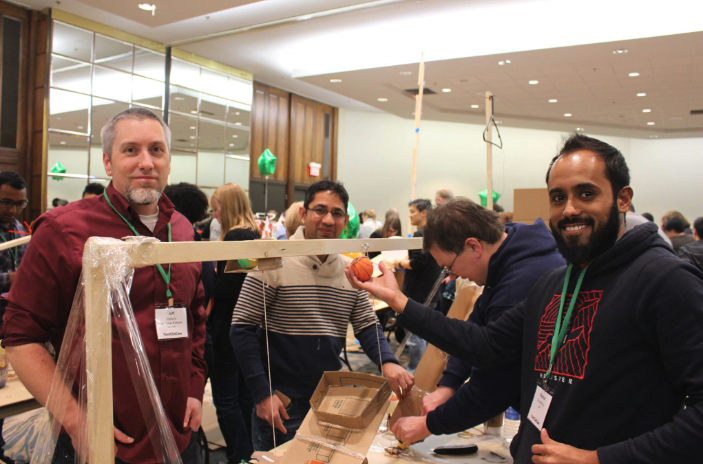Transform Your Professional Environment: 8 Active Listening Exercises for Work

More so than ever before, effective communication is essential for organizations. And in order to ensure your staff are expert communicators, it’s important to practice active listening exercises for work.
Effective communication is the cornerstone of a successful and productive work environment, and active listening is a key piece of that puzzle. By encouraging the regular practice of active listening exercises for work, you can help enhance:
- Team dynamics
- Employee satisfaction
- Collaboration
- Overall business performance
This isn’t just a nice to have. It’s a must.
In fact, poor communication has been shown to have a massive cost—in the ballpark of $62.4 million annually for large organizations and $420,000 per year for smaller ones.
So, we’ve crafted this resource to help you use active listening exercises for work as a means to solve some of the macro and micro challenges caused by poor communication.
- The Importance of Active Listening Exercises for Work
- 1. Active Listening Exercises Enhance Communication and Reduce Misunderstandings
- 2. Active Listening Helps to Build Trust and Fostering Positive Relationships
- 3. Active Listening Exercises Encourage a Collaborative Work Culture
- 4. Active Listening Exercises at Work Support Effective Problem-Solving and Decision-Making
- 5 Essential Active Listening Skills for the Workplace
- Paying Full Attention and Avoiding Distractions
- Demonstrating Empathy and Understanding
- Asking Open-Ended Questions and Providing Feedback
- Summarizing and Paraphrasing Information
- 8 Effective Active Listening Exercises for Work
The Importance of Active Listening Exercises for Work

Putting a greater emphasis on active listening in the workplace can help to improve four common workplace pain points.
1. Active Listening Exercises Enhance Communication and Reduce Misunderstandings
Misunderstandings and communication breakdowns can be massive timewasters, not to mention hinderers of employee morale.
But in the era of digital communication, they’re more common than ever. Interacting via email, direct messages, or even video conferencing can hinder our ability to pick up on non-verbal cues, like tone of voice, body language, and facial expressions.
Active listening exercises help your team make it a habit to pay closer attention to verbal and non-verbal cues—whether in-person or online—to avoid misinterpretation and respond more effectively.
And when this happens, you’ll experience fewer conflicts and errors as well as less wasted time dedicated to solving disputes that may not have needed to happen in the first place.
For even more insights on this topic, check out our guide to effective communication in the workplace.
2. Active Listening Helps to Build Trust and Fostering Positive Relationships
There’s nothing more frustrating than feeling like someone isn’t actually listening to you but rather just waiting for their turn to speak.
Active listening exercises help to alleviate this frustration.
By practicing active listening, you’re signaling to the speaker that their thoughts and opinions are valued, in turn helping to forge mutual respect and trust.
And when people feel heard and understood, both in the moment and as a generality, they’re more likely to be engaged and motivated in the discussion—and in their roles.
Ultimately, better workplace relationships contribute to higher employee satisfaction, retention, and a more positive work environment.
3. Active Listening Exercises Encourage a Collaborative Work Culture
There are no two ways about it: in the past few years, collaboration has become infinitely more challenging.
But in a professional environment where success requires collaboration, this isn’t a skill that should be allowed to fall by the wayside. It’s essential that your people feel empowered to contribute their unique perspectives and skills.
By practicing active listening exercises at work, you’ll empower your team to share ideas and provide constructive feedback without the fear of being dismissed or misunderstood.
And this can have tangible benefits to your organization’s bottom line: research has shown that companies with collaborative cultures and more likely to be high-performing and have higher levels of employee engagement.
4. Active Listening Exercises at Work Support Effective Problem-Solving and Decision-Making
Active listening fosters open and honest communication, enabling team members to effectively identify, discuss, and address problems. By fully understanding different perspectives, employees can make more informed decisions that benefit their teams and the entire organization at large.
5 Essential Active Listening Skills for the Workplace

Whether you’re a business leader, a human resources manager, an entry-level employee, or anyone in between, there are five important active listening skills to master in the workplace.
Paying Full Attention and Avoiding Distractions
It’s vital to be fully present and engaged during conversations, and you can do this by eliminating distractions like phones, emails, and multitasking.
But it’s not just about the things you cut out—it’s also about the things you do proactively.
This includes nonverbal cues, like eye contact and nodding along, as well as acknowledging and repeating what people have said (but there’s more to come about this).
Demonstrating Empathy and Understanding
When someone’s speaking to you, it’s not enough to just listen to the words they’re saying. You also need to focus on recognizing and validating their emotions and perspectives.
And here’s the rub: this is sometimes easier said than done. It often requires reading between the lines and focusing on finding cues in their voice and body language.
But when you put in the effort to do so, you can avoid judgment, foster a safe and open environment for communication, and find common ground within the conversation.
We dive deeper into this—and other similar topics—in our comprehensive guide to developing emotional intelligence for leaders.
Asking Open-Ended Questions and Providing Feedback
The most productive conversations are two-way—not one-way. That’s why it’s important to encourage deeper exploration of thoughts and ideas by:
- Asking open-ended questions
- Seeking clarification and additional information to ensure you have a clear understanding of what the other person is saying
- Providing constructive feedback that acknowledges the speaker’s perspective and offers insights or suggestions
- Balancing inquiry and advocacy to promote a productive dialogue that values diverse opinions and perspectives
Actively participating in the discussion rather than simply taking in what’s being said will create much more impactful outcomes.
Summarizing and Paraphrasing Information
It may seem redundant or repetitive, but summarizing and paraphrasing things you hear during conversations can provide benefits on both sides of the dialogue.
You can try things like:
- Demonstrating your understanding of what’s being said by restating key points and ideas in your own words
- Asking the speaker to confirm or correct your interpretation to make sure you’re picking up what they’re putting down
- Reinforcing the value of the conversation by highlighting its main takeaways
Don’t be afraid to repeat things you say. It’ll show the person you’re talking to that you’re actually actively engaged in the discussion.
If you’re interested in learning more about essential leadership skills, check out our resource on the 14 soft skills every leader needs, according to real-world professionals.
8 Effective Active Listening Exercises for Work

We’ve covered a ton of the benefits of active listening as well as some of the key active listening skills your team can master, but the big question is how to actually make it all happen.
And that’s where these 8 active listening exercises for work come into play.
1. The Reflective Listening Activity
In this exercise, your team will break out into pairs. Then, each person will take turns sharing a work-related experience or challenge while their partner practices reflective listening.
The listener’s goal is to understand the speaker’s perspective and feelings and then reflect that understanding back to the speaker.
Here’s how it works:
- Divide participants into pairs
- Allocate 5-7 minutes for each person to share their experience while their partner listens
- The listener should practice active listening skills, such as making eye contact, nodding, and asking clarifying questions
- After the speaker has finished, the listener should summarize the key points and emotions expressed by the speaker
- Switch roles and repeat the process
This active listening exercise will help your team to:
- Develop empathy and understanding among team members
- Practice open and honest communication
- Prioritize active listening skills, including summarizing and reflecting
2. Clear Communication

With Outback’s Clear Communication professional skills training workshop, you can develop your team’s overall communications abilities.
Led by an experienced professional facilitator, this program provides corporate groups with the opportunity to not only hone their verbal and written skills, but also:
- Learn non-verbal communication signals
- Make their presentations more impactful
- Communicate effectively during conflicts and decisions
3. The Silent Brainstorming Session
Silent brainstorming sessions help participants practice active listening by focusing solely on the ideas being presented without the pressure of responding immediately or competing for attention.
Here’s how to do it:
- Choose a topic or problem relevant to your organization
- Ask participants to write down their ideas or solutions on sticky notes, one idea per note
- Place the sticky notes on a whiteboard or designated area, grouping similar ideas together
- Invite participants to silently review the ideas presented and add any additional thoughts or suggestions on new sticky notes
- After a designated time, facilitate a group discussion to explore the ideas further, encouraging active listening and open dialogue
This active listening exercise for work:
- Encourages focused listening and thoughtful consideration of others’ ideas
- Promotes creativity and innovation by valuing diverse perspectives
- Fosters a collaborative environment that supports effective problem-solving
4. The Active Listening Role-Play
While it might take a minute for people to get comfortable being outside of their comfort zone role-playing scenarios can be an effective way to practice active listening skills in realistic work-related situations.
Not sure where to start? Here are a few steps to bring this active listening exercise to life:
- Develop a set of scenarios that reflect common communication challenges within your organization
- Divide participants into pairs or small groups and assign each a specific scenario
- Instruct participants to role-play the scenario, with one person acting as the speaker and the other(s) as the listener(s)
- Encourage the listener(s) to practice active listening skills, such as asking open-ended questions, demonstrating empathy, and summarizing the speaker’s key points
- After each scenario, facilitate a brief debriefing session to discuss the experience and identify areas for improvement
Once people get past the preliminary nerves that come with role-playing, this active listening exercise:
- Provides an opportunity to practice active listening skills in a controlled environment
- Helps participants identify and address communication challenges specific to their organization
- Supports the development of empathy and understanding among team members
5. Domino Effect Challenge

In this hands-on, high-energy team building activity, your group will split into teams that will need to complete their own respective section of a chain reaction machine.
Here’s how it works:
- Your group breaks out into teams
- Each team is provided with a random assortment of materials
- Using the materials at their disposal, they’ll need to create one piece of a bigger chain reaction machine
- Once each team has assembled its own portion, they’ll need to come together to collaboratively assemble their sections into a fully functioning device
While this activity leans into fun, it also provides a ton of benefits including:
- Encouraging active listening and communication, both in small groups as well as a large team
- Requires individuals to collaborate closely in order to achieve their ultimate goal
6. The Paraphrasing Challenge
The paraphrasing challenge is a simple yet effective way to improve active listening skills by focusing on accurately understanding and restating information.
Here’s how to organize it in five steps:
- Prepare a list of work-related statements or facts
- Divide participants into pairs
- One participant reads a statement, and the other must paraphrase the statement in their own words
- The speaker then confirms whether the paraphrase is accurate or offers corrections as needed
- Participants switch roles and continue with the remaining statements
Not only is this active listening exercise fun, it also ties into key skills and:
- Enhances participants’ ability to summarize and restate information accurately
- Improves information retention and comprehension
- Reinforces the importance of active listening in effective communication
7. Corporate Castaways

Ever wondered how your team would fare if they got stranded on a deserted island? Well, now you can find out! This hosted activity will have your large group split into “tribes” to tackle fun physical and mental challenges in a competition inspired by the “Survivor” TV show.
The premise of this game is simple:
- Your group breaks out into teams
- Each team is challenged to come up with unique tribe names and flags
- Each tribe will have to strategize to complete as many challenges as possible before time runs out
- The tribe that earns the most points will be crowned Corporate Castaway champions
While it’s infused with a competitive edge, this event is an exercise in active listening because it requires teams to work closely and collaboratively as they talk and work through a wide array of challenges.
8. The Listening Circle
This is a simple, easy exercise that promotes active listening and constructive feedback within a group setting. The goal of The Listening Circle is to foster open communication and collaboration.
Here’s how to do it:
- Arrange participants in a circle, either seated or standing
- Choose a topic or prompt relevant to your organization, such as a recent project, upcoming event, or a specific challenge
- Starting with one participant, each person shares their thoughts or ideas on the topic
- As each participant speaks, the rest of the group practices active listening, focusing on understanding the speaker’s perspective and emotions
- After each person has shared, open the floor for group discussion and feedback. Encourage participants to use active listening skills, such as asking open-ended questions, summarizing key points, and offering constructive feedback
- Close the exercise by highlighting the main takeaways and discussing ways to apply active listening skills in daily work interactions
This active listening exercise offers an array of benefits, including:
- Encouraging open and honest communication within a group setting
- Strengthening active listening skills, such as empathy, summarizing, and providing constructive feedback
- Fostering a collaborative work environment where diverse perspectives are valued
By incorporating these active listening exercises for work into your organization, you can empower your team with the skills necessary for effective communication, stronger relationships, and enhanced collaboration.
Does your organization already practice active listening exercises for work? If so, what are they and how do they help? Share your thoughts in the comments section below!
Learn how team building and corporate training sessions support active listening exercises for work.
If you’ve got questions about how team building and training can help improve your team’s active listening skills, reach out to an Employee Engagement Consultant




Comments